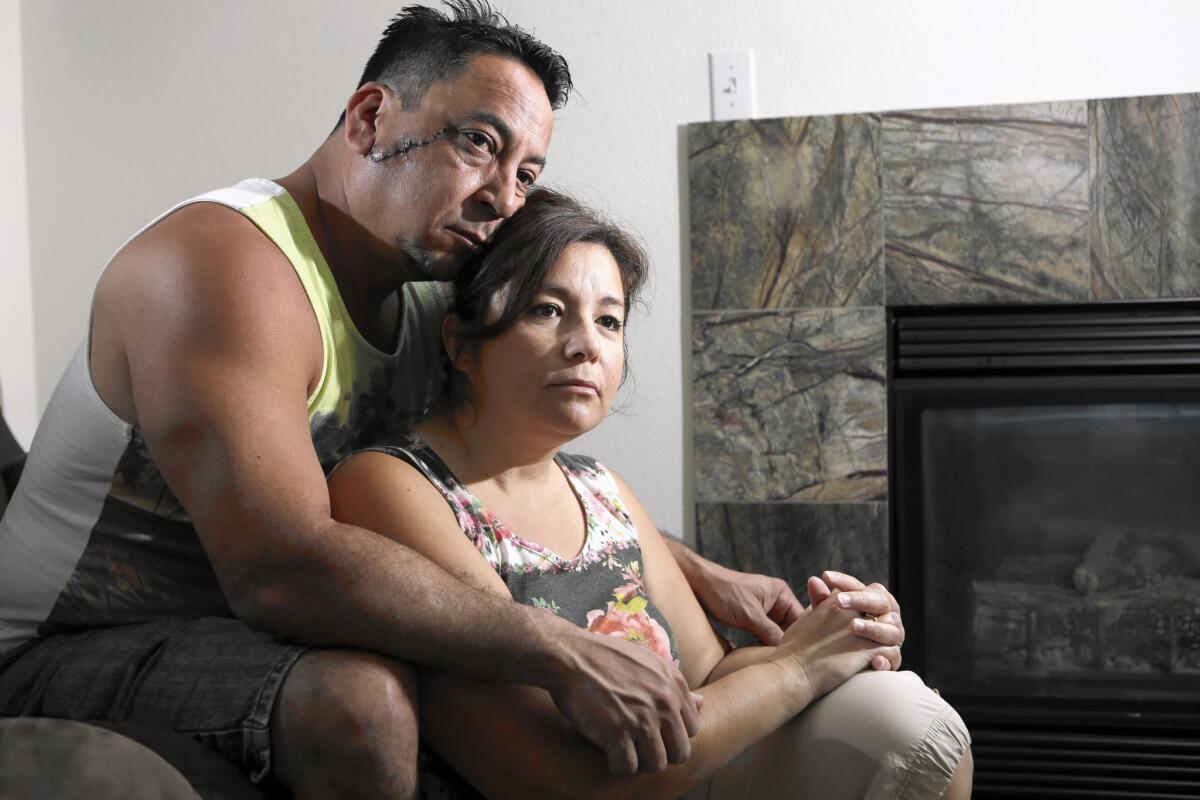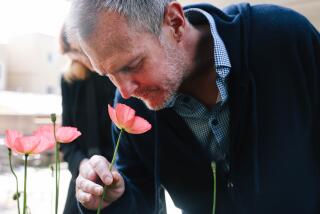Great Read: The nightmare outcome of a son’s mental illness

Anthony, left, and Cynthia Hernandez at their home in Chino. Both of them were stabbed by their mentally ill son, Aaron; the scar from the attack on Anthony is visible on his face.
Cynthia Hernandez was thinking about the missing dog when she awoke early that September morning in her family’s two-story tract home, tucked away in a residential enclave north of a busy commercial corridor in Chino.
The 10-year-old cocker spaniel, Sandy, hadn’t been seen since the day before. She went outside to call the dog again, without luck. She came back in, took a shower and began ironing clothes for work.
Her husband, Anthony, was in bed browsing the Internet on his new tablet. He didn’t look up when their 19-year-old son, Aaron, walked into the room. Aaron and his mother had argued about the missing dog, and Anthony wasn’t in the mood to talk to his son now.
Aaron’s behavior had been spinning out of control.
He was convinced he was being poisoned by trucks passing on the nearby thoroughfare. Smells and loud noises upset him; he would grow incensed if his mother burned a tortilla in the kitchen or his grandmother had the television volume too high in her room. He punched holes in the wall and talked about killing himself. Once, his mother said, he told her he dreamed that he had killed her.
It was obvious to Cynthia that her son was a danger. She and Anthony had sought help from California’s medical, legal and law enforcement institutions. But they had found only temporary relief, and were frustrated by the piecemeal and often impenetrable nature of the state’s mental health system.
“I felt that one day I would come home and find him dead in the house or that he would hurt somebody in the family,” Cynthia said later. “We always felt that. We lived with that every day.”
On that September day, Aaron walked up to his father as he sat reading in bed and raised a baseball bat above his head.
::
The youngest of three children, Aaron was an artistic kid who loved playing guitar and the video game “Halo.” A lifelike drawing he made for his grandmother of Sandy, the cocker spaniel, stands out in the collection his family keeps.
In middle school, he began using marijuana and, later, hallucinogens. After repeated attempts to control his drug use, his parents decided it was linked to an underlying mental health problem.
Psychiatrists began offering assessments of what Aaron’s trouble might be and finally settled on a diagnosis: paranoid schizophrenia.
Aaron’s father was well aware of mental illness: Other family members had been diagnosed with schizophrenia and bipolar disorder.
In the 21/2 years leading up to that September morning, Aaron and his parents had been stuck in a nightmare cycle. He had been taken to a psychiatric hospital eight times on 72-hour involuntary hospitalizations, known by police and mental health workers as a “5150 hold.”
The forced holds are reserved for people who pose an immediate danger to themselves or others or are too mentally ill to care for their own basic needs. That can be extended for 14 more days, or sometimes longer, when the patient is found to need more intensive intervention.
After a few days or at most a couple of weeks in the hospital, staff would release Aaron and he would refuse to follow up on treatment and deteriorate again.
In the most extreme cases, a court may order the patient placed under a conservatorship, allowing a family member or other court-appointed person to make medical decisions on their behalf for a year or more. In many cases, that means placing the patient in a locked psychiatric facility and sometimes forcibly administering medication.
But how the state law is applied by each of California’s 58 counties depends on the money and beds available and the philosophy of county officials, doctors and judges.
“What has in essence happened is that every county has sort of crafted the rules that meet their needs the best,” says Sheree Kruckenberg, vice president of behavioral health for the California Hospital Assn. The result, she says, has been “very divergent applications of people’s civil rights from county to county, city to city, hospital to hospital and even from physician to physician.”
Some counties report high rates of 72-hour holds but rarely hold patients longer. Others detain fewer people but keep them longer. And some counties are far more likely than San Bernardino County, where the Hernandez family lives, to initiate the conservatorship process when a patient is referred to them.
A few California counties, including Los Angeles and Orange but not San Bernardino, have begun to implement Laura’s Law, a measure that permits courts to order outpatient treatment of people with severe mental illness. The law’s criteria are less strict than those for conservatorship, and it does not require patients to submit to involuntary medication.
Still, some civil liberty and patients’ rights advocates have argued that this expanded use of forced treatment infringes on patients’ rights.
Melinda Bird, director of litigation for Disability Rights California, says the real breakdown in the system is that there aren’t enough voluntary treatment services and too little effort made by healthcare providers and county officials to engage people like Aaron in the existing programs.
“No one has shown me an individual who could not be engaged if approached in a way that made sense to them,” she says. “You don’t need to force treatment. It is ultimately counterproductive and incredibly expensive.”
State Assemblywoman Susan Eggman (D-Stockton), who wants to expand the use of Laura’s Law, points out that people whose mental illness goes untreated often end up incarcerated.
“We see this as a way of potentially increasing people’s freedoms,” she says.
::
Unable to control Aaron, his parents kicked him out of the house twice after he turned 18 in 2013.
During the first stint of homelessness, he was arrested on charges of indecent exposure and having an open container of alcohol. The case is pending. During the second, he landed in the emergency room with a skull fracture. He said someone hit him with a skateboard.
Shaken by each incident, his parents took him back in, but his behavior made them increasingly anxious.
In a video Anthony saved on his cellphone, Aaron — slight and dark-haired, with a pockmarked face — paces back and forth, cursing and covering his ears as he argues with his parents.
“I wish I could go outside, but I can’t, because people are going to be throwing their cars at me and throwing all kinds of fumes in the air and I can’t even breathe in my own neighborhood,” Aaron says.
Anthony and Cynthia wrote up a document outlining their son’s medical history and said they would bring it to Canyon Ridge, a private psychiatric hospital in Chino, each time Aaron was detained there.
They wanted the doctors to make a referral to the county of San Bernardino, which would then decide whether to file a court petition seeking a mental health conservatorship for Aaron. But Canyon Ridge never made that referral, Anthony and Cynthia say.
Representatives of the hospital did not respond to repeated requests for comment.
Advocates and healthcare providers said there can be disincentives against doctors recommending conservatorships and counties pursuing them, including the strict requirements for a patient to qualify, the time it takes a doctor to argue the case in court, and the shortage of long-term beds for psychiatric patients.
Even in cases in which the provider recommends a conservatorship, the county still has to make a decision to pursue the case.
In some counties, like Los Angeles and Alameda, the public guardian’s office files a court petition nearly every time a healthcare provider refers a patient for a conservatorship, according to data provided in response to requests by The Times. L.A., for instance, has filed petitions on 100% of the approximately 1,200 referrals it received each year. In San Bernardino County, the average was 34%.
Karen Cervantes, a spokeswoman for the San Bernardino County Department of Behavioral Health, said investigators petition for conservatorship only when “there are no other alternatives available.” It’s not clear what the county would have decided if the private psychiatric hospital where Aaron was taken during his 5150 commitments had referred him for evaluation.
::
On the day before he raised the bat above his father’s head, Cynthia said Aaron told her that a demon had appeared in a car’s exhaust.
She called the county mental health crisis team and tried to put Aaron on the phone with them, but he refused, she said. The crisis unit sent a police officer to the house. By the time he arrived, however, Aaron had calmed down. When the officer asked if he wanted to hurt himself or anyone else, he said no.
Later that day, with his father at work and his mother out on an errand, Aaron led the family spaniel, Sandy, outside. He lifted a baseball bat and brought it down on the dog, pounding her until she was dead.
The next morning, Aaron brought the same bat down on his father. Twice.
Anthony, a stocky 52-year-old, managed to wrest the bat from his 110-pound son. He didn’t see the knife in Aaron’s other hand until the young man sank it into his temple.
“Why are you doing this, son?” Anthony asked. “They’re going to take you to jail.”
“Just die, Dad,” Aaron said. “Just die.”
Cynthia ran outside to look for help. Aaron found her in a neighbor’s yard, and slashed and stabbed her too.
Emergency room doctors were able to stitch up Anthony and Cynthia’s wounds — including one gash on the mother’s neck that barely missed an artery. They pulled a fragment of the knife from her scalp.
Police officers chased down Aaron and subdued him with a Taser. He has been jailed ever since on charges of attempted murder and animal cruelty, to which he pleaded not guilty. In late March, a San Bernardino County Superior Court judge decided that he was competent to stand trial. A trial date has not been set.
::
From the beginning, Aaron called his parents from jail every day and sent rambling letters with drawings of heroes and monsters. Anthony goes two or three times a week to visit him. It took Cynthia longer to work up the nerve to face her son after the attack. Aaron’s brother and sister do not speak to him.
After a couple of months in jail, Aaron began taking medication. His letters changed, becoming more coherent, his parents say. He began to write about feeling remorse.
Both parents say they want their son to go to a state hospital for treatment, not to prison.
“I’m almost relieved that it happened this way, because now we’re going to have something done,” Anthony said the week after the attack, a stitched-up gash running all the way from his eye to his ear. “Which is odd to say and strange to feel this way. But this is what we’re left with.”
In a jailhouse interview with The Times, Aaron chokes up when he describes killing Sandy.
“I thought, I can’t believe this, I just took my dog’s life that I love so much,” he says. “It was the evil within me trying to take over the so-called anger I had stored up inside of me.”
The same bat could have killed his father. He says his mind is clearer now.
“I’m really thankful that my parents are still here.”
Times staff writers Sandra Poindexter and Doug Smith contributed to this report.
ALSO
Antidepressants rapidly alter brain architecture, study finds
Intervention lowers drug, crime and behavior problems, but not by much
New funds jump-start mental illness research
More to Read
Start your day right
Sign up for Essential California for news, features and recommendations from the L.A. Times and beyond in your inbox six days a week.
You may occasionally receive promotional content from the Los Angeles Times.







